Psychological Stress Level Detection Based on Heartbeat Mode
Abstract
:1. Introduction
2. Heartbeat Mode-Based Stress Detection Algorithm
2.1. Drivedb Database and Recognition Strategy
2.1.1. Drivedb Database
2.1.2. Recognition Strategy
2.2. ECG Signal Preprocessing
2.3. Sample Length Selection
2.4. Feature Extraction with bmNN
2.5. Classification
2.5.1. Classifier for Classification
2.5.2. Heartbeat Mode Analysis
2.5.3. Classification Steps
- The single driving data of the 10 driving datasets were first classified on two stress levels: rest or driving (0\1 + 2). All 16 values for bm were traversed, and the bm with the highest classification accuracy was recorded as the optimal bm for this round of driving classification.
- For the data with classification accuracy higher than 80% among the 10 driving tests, classification was carried out after merging all datasets. Similarly, all 16 values of bm were traversed, and the bm with the highest classification accuracy was recorded and taken as the reference bm value for all classification tasks. For each round of classification, three different feature values were calculated (i.e., avNN, reference bmNN, and optimal bmNN).
- For data with classification accuracy lower than 80% among the 10 driving tests in Step 1, the classification accuracies for the 0 and 1 + 2 categories were recorded alongside the total accuracy of each driving dataset. Simultaneously, GSR signal waveform fluctuations during Rest were observed, and the reasons for the changes in classification accuracy were analyzed.
3. Results
3.1. Classification Results of Driving Datasets with Accuracy above 80%
3.2. Classification Results of Driving Datasets with Accuracy below 80%
3.3. Interpretation of Results
4. Discussion
5. Conclusions
Author Contributions
Funding
Institutional Review Board Statement
Informed Consent Statement
Data Availability Statement
Acknowledgments
Conflicts of Interest
References
- Alshamrani, M. An Advanced Stress Detection Approach based on Processing Data from Wearable Wrist Devices. Int. J. Adv. Comput. Sci. Appl. 2021, 12, 399–405. [Google Scholar] [CrossRef]
- Iqbal, T.; Redon-Lurbe, P.; Simpkin, A.J.; Elahi, A.; Ganly, S.; Wijns, W.; Shahzad, A. A Sensitivity Analysis of Biophysiological Responses of Stress for Wearable Sensors in Connected Health. IEEE Access 2021, 9, 93567–93579. [Google Scholar] [CrossRef]
- Samson, C.; Koh, A. Stress Monitoring and Recent Advancements in Wearable Biosensors. Front. Bioeng. Biotechnol. 2020, 8, 1037. [Google Scholar] [CrossRef]
- Thayer, J.F.; Åhs, F.; Fredrikson, M.; Sollers, J.J.; Wager, T.D. A meta-analysis of heart rate variability and neuroimaging studies: Implications for heart rate variability as a marker of stress and health. Neurosci. Biobehav. Rev. 2012, 36, 747–756. [Google Scholar] [CrossRef]
- Elgendi, M.; Menon, C. Machine Learning Ranks ECG as an Optimal Wearable Biosignal for Assessing Driving Stress. IEEE Access 2020, 8, 34362–34374. [Google Scholar] [CrossRef]
- Dalmeida, K.M.; Masala, G.L. Hrv features as viable physiological markers for stress detection using wearable devices. Sensors 2021, 21, 2873. [Google Scholar] [CrossRef]
- Shaffer, F.; Ginsberg, J.P. An Overview of Heart Rate Variability Metrics and Norms. Front. Public Health 2017, 5, 258. [Google Scholar] [CrossRef] [Green Version]
- Kim, H.G.; Cheon, E.J.; Bai, D.S.; Lee, Y.H.; Koo, B.H. Stress and heart rate variability: A meta-analysis and review of the literature. Psychiat. Investig. 2018, 15, 235–245. [Google Scholar] [CrossRef] [Green Version]
- Kumar, M.; Zhang, W.; Weippert, M.; Freudenthaler, B. An Explainable Fuzzy Theoretic Nonparametric Deep Model for Stress Assessment Using Heartbeat Intervals Analysis. IEEE Trans. Fuzzy Syst. 2020, 29, 3873–3886. [Google Scholar] [CrossRef]
- Burma, J.S.; Graver, S.; Miutz, L.N.; Macaulay, A.; Copeland, P.V.; Smirl, J.D. The validity and reliability of ultra-short-term heart rate variability parameters and the influence of physiological covariates. J. Appl. Physiol. 2021, 130, 1848–1867. [Google Scholar] [CrossRef]
- Zhao, L.; Li, P.; Li, J.; Liu, C. Influence of ectopic beats on heart rate variability analysis. Entropy 2021, 23, 648. [Google Scholar] [CrossRef] [PubMed]
- Lombardi, F.; Huikuri, H.; Schmidt, G.; Malik, M. Short-term heart rate variability: Easy to measure, difficult to interpret. Heart Rhythm 2018, 15, 1559–1560. [Google Scholar] [CrossRef] [PubMed] [Green Version]
- Shaffer, F.; Meehan, Z.M.; Zerr, C.L. A critical review of ultra-short-term heart rate variability norms research. Front. Neurosci. 2020, 14, 594880. [Google Scholar] [CrossRef] [PubMed]
- Roman-Juan, J.; Bornas, X.; Zuzama, N.; Fiol-Veny, A.; Balle, M. Decrements in Adolescent Cardiac Complexity During Mother-Adolescent Conflicts. Appl. Psychophysiol. Biofeedback 2021, 46, 259–270. [Google Scholar] [CrossRef]
- Kimmel, M.C.; Fransson, E.; Cunningham, J.L.; Brann, E.; Grewen, K.; Boschiero, D.; Chrousos, G.P.; Meltzer-Brody, S.; Skalkidou, A. Heart rate variability in late pregnancy: Exploration of distinctive patterns in relation to maternal mental health. Transl. Psychiat. 2021, 11, 286. [Google Scholar] [CrossRef]
- McCraty, R.; Zayas, M.A. Cardiac coherence, self-regulation, autonomic stability and psychosocial well-being. Front. Psychol. 2014, 5, 1090. [Google Scholar] [CrossRef] [Green Version]
- Pereira, T.; Almeida, P.R.; Cunha, J.P.S.; Aguiar, A. Heart rate variability metrics for fine-grained stress level assessment. Comput. Meth. Prog. Biomed. 2017, 148, 71–80. [Google Scholar] [CrossRef]
- Gedam, S.; Paul, S. A Review on Mental Stress Detection Using Wearable Sensors and Machine Learning Techniques. IEEE Access 2021, 9, 84045–84066. [Google Scholar] [CrossRef]
- Healey, J.A.; Picard, R.W. Detecting stress during real-world driving tasks using physiological sensors. IEEE Trans. Intell. Transp. Syst. 2005, 6, 156–166. [Google Scholar] [CrossRef] [Green Version]
- Goldberger, A.L.; Amaral, L.A.; Glass, L.; Hausdorff, J.M.; Ivanov, P.C.; Mark, R.G.; Mietus, J.E.; Moody, G.B.; Peng, C.K.; Stanley, H.E. PhysioBank, PhysioToolkit, and PhysioNet: Components of a new research resource for complex physiologic signals. Circulation 2000, 101, e215–e220. [Google Scholar] [CrossRef] [Green Version]
- Chen, L.; Zhao, Y.; Ye, P.; Zhang, J.; Zou, J.Z. Detecting driving stress in physiological signals based on multimodal feature analysis and kernel classifiers. Expert Syst. Appl. 2017, 85, 279–291. [Google Scholar] [CrossRef]
- Aristizabal, S.; Byun, K.; Wood, N.; Mullan, A.F.; Porter, P.M.; Campanella, C.; Jamrozik, A.; Nenadic, I.Z.; Bauer, B.A. The Feasibility of Wearable and Self-Report Stress Detection Measures in a Semi-Controlled Lab Environment. IEEE Access 2021, 9, 102053–102068. [Google Scholar] [CrossRef]
- Liu, Y.; Du, S. Psychological stress level detection based on electrodermal activity. Behav. Brain Res. 2018, 341, 50–53. [Google Scholar] [CrossRef] [PubMed]
- Pan, J.; Tompkins, W.J. A Real-Time QRS Detection Algorithm. IEEE Trans. Biomed. Eng. 1985, 32, 230–236. [Google Scholar] [CrossRef] [PubMed]
- Wang, J.S.; Lin, C.W.; Yang, Y.T.C. A k-nearest-neighbor classifier with heart rate variability feature-based transformation algorithm for driving stress recognition. Neurocomputing 2013, 116, 136–143. [Google Scholar] [CrossRef]
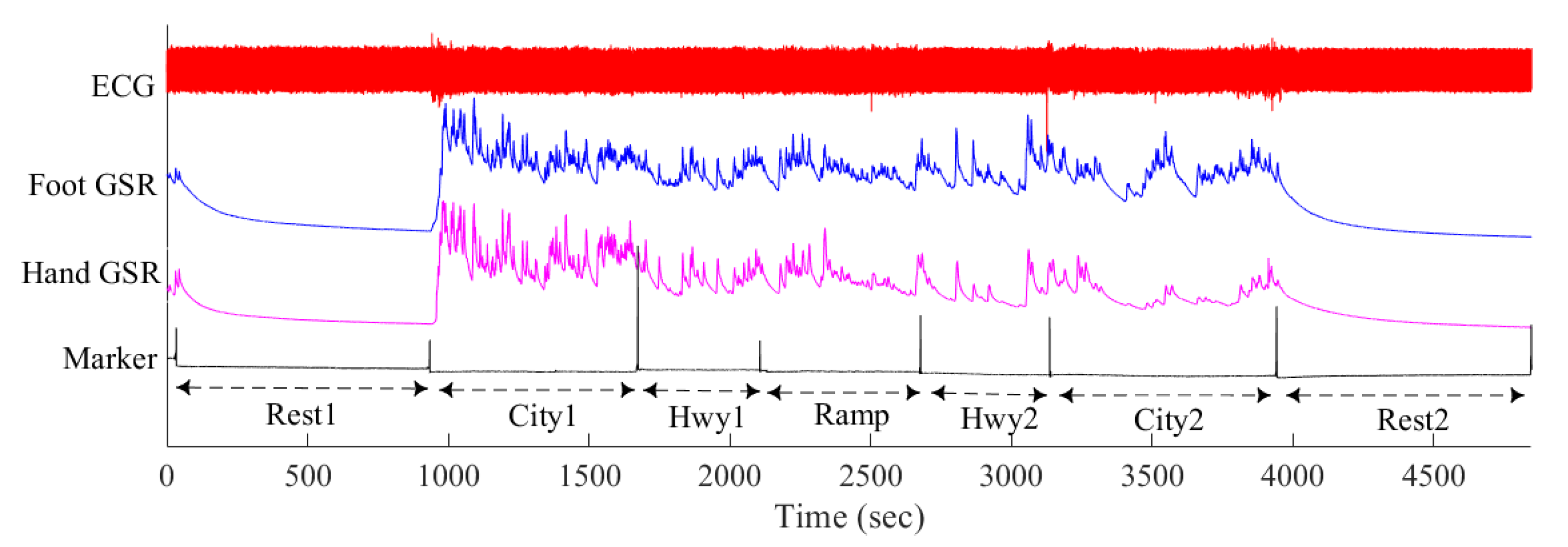
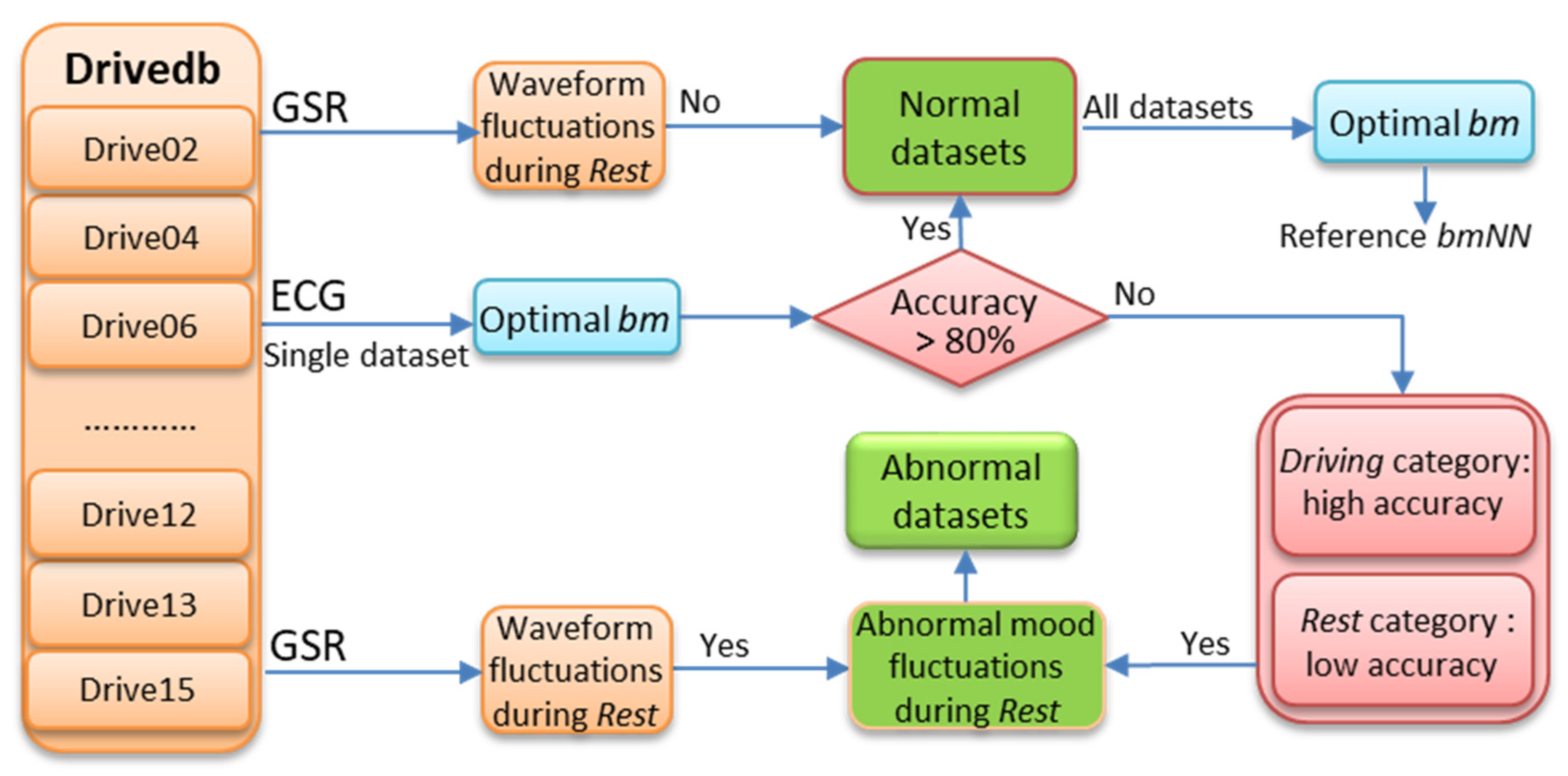

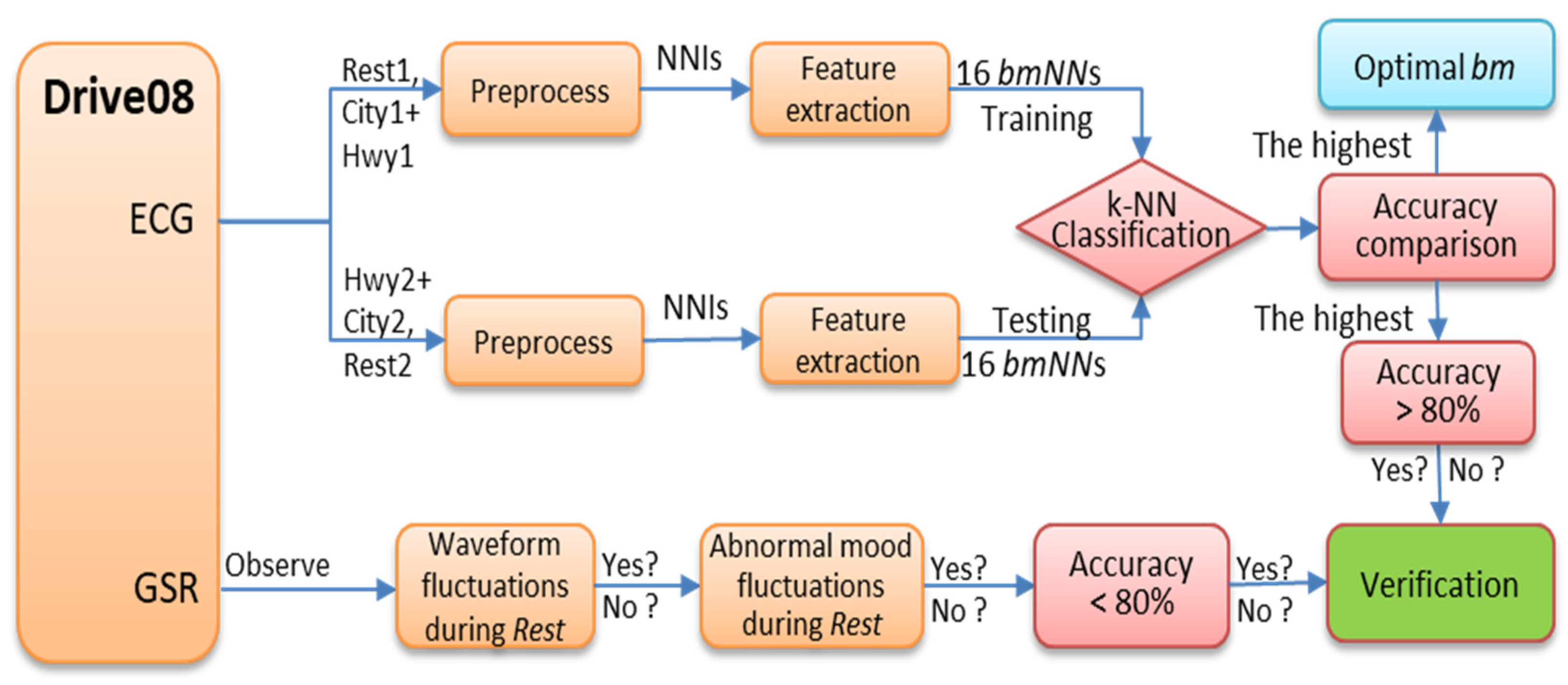
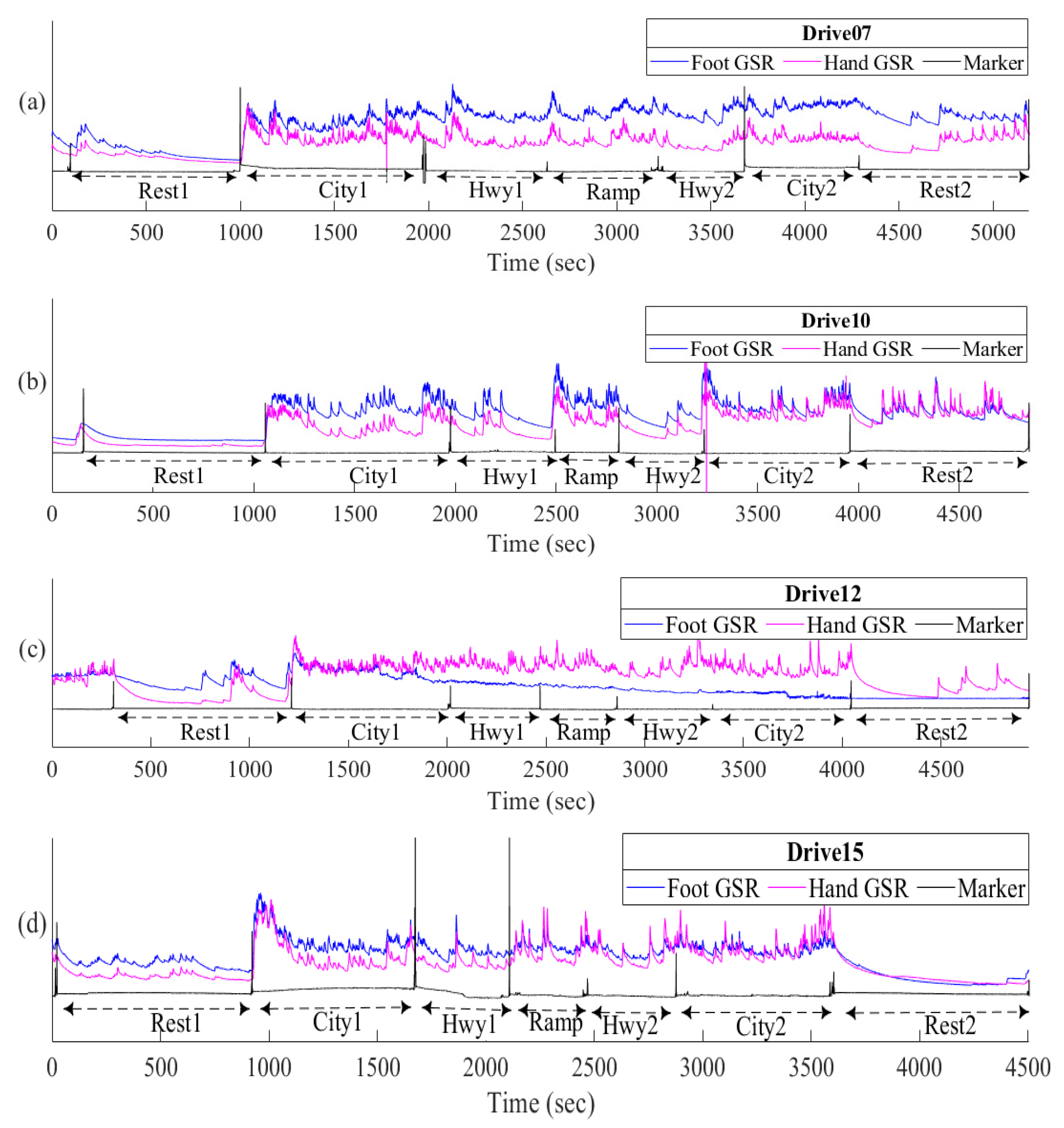

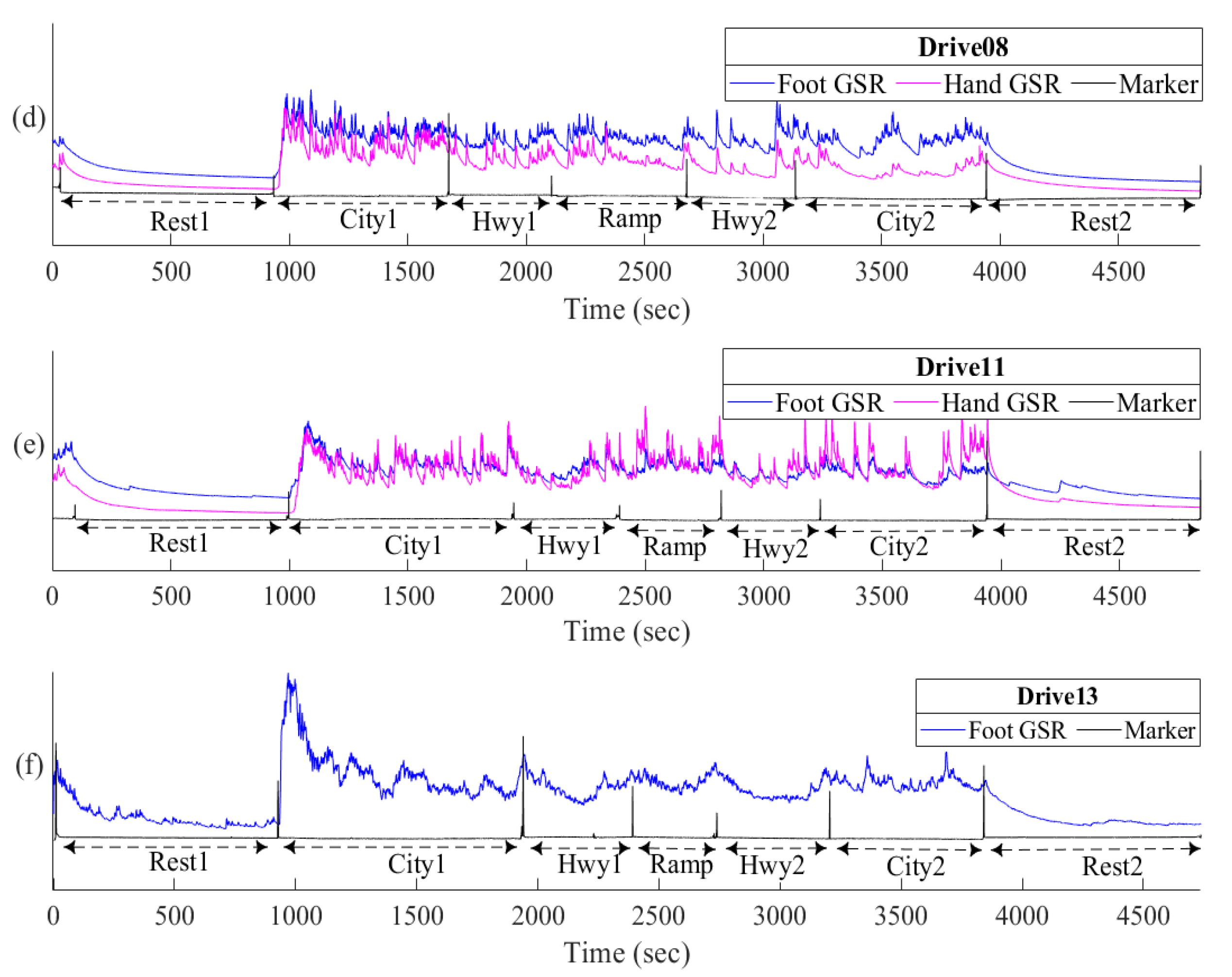
| Rec. Name | Sample Size/Time (s) | Total Rec. Time (s) | |||||
|---|---|---|---|---|---|---|---|
| Rest1 | City1 | Hwy1 | Hwy2 | City2 | Rest2 | ||
| Drive02 | 77/900 | 60/700 | 24/400 | 14/300 | 72/800 | 68/800 | 5000 |
| Drive04 | 81/900 | 95/900 | 30/400 | 5/200 | 39/500 | 51/700 | 4800 |
| Drive06 | 102/900 | 108/740 | 38/390 | 29/350 | 89/710 | 92/870 | 4780 |
| Drive07 | 89/900 | 84/800 | 54/600 | 28/400 | 42/500 | 72/800 | 5100 |
| Drive08 | 64/800 | 49/600 | 22/400 | 21/400 | 53/700 | 64/1100 | 4840 |
| Drive10 | 74/800 | 74/700 | 41/480 | 26/360 | 61/600 | 84/800 | 4800 |
| Drive11 | 66/870 | 70/830 | 19/370 | 18/350 | 45/600 | 54/800 | 4800 |
| Drive12 | 56/800 | 54/760 | 22/400 | 26/430 | 48/620 | 64/800 | 4900 |
| Drive13 | 90/800 | 135/900 | 43/370 | 41/380 | 71/550 | 91/800 | 4700 |
| Drive15 | 69/870 | 51/660 | 16/340 | 11/300 | 47/600 | 65/850 | 4500 |
| Classes | Features | Accuracy (%) | |||||||
|---|---|---|---|---|---|---|---|---|---|
| Mean | Drive02 | Drive04 | Drive06 | Drive08 | Drive11 | Drive13 | Total | ||
| 0\1 + 2 | avNN | 76.1 | 70.1 | 68.4 | 91.0 | 26.8 | 100 | 100 | 70.9 |
| bmNN/bm = 12 | 87.0 | 92.9 | 98.9 | 92.9 | 100 | 82.1 | 55.2 | 77.1 | |
| optimal bmNN | 93.7 | 92.9 | 100 | 94.8 | 100 | 83.8 | 90.6 | 77.1 | |
| 0\1\2 | avNN | 59.1 | 50.6 | 63.2 | 61.0 | 13.8 | 79.5 | 86.2 | 57.9 |
| bmNN/bm = 12 | 69.1 | 77.3 | 94.7 | 68.6 | 96.4 | 59.0 | 18.7 | 50.4 | |
| optimal bmNN | 81.7 | 77.3 | 95.8 | 68.6 | 96.4 | 73.5 | 78.8 | 52.9 | |
| Rec. Name | Features | Average Feature Values | ||||||||
|---|---|---|---|---|---|---|---|---|---|---|
| 0 | 1 | 2 | ||||||||
| Mean | Rest1 | Rest2 | Mean | Hwy1 | Hwy2 | Mean | City1 | City2 | ||
| Drive02 | avNN | 0.904 | 0.915 | 0.893 | 0.878 | 0.888 | 0.867 | 0.850 | 0.843 | 0.856 |
| bmNN/12 | 0.147 | 0.135 | 0.158 | 0.117 | 0.107 | 0.127 | 0.089 | 0.076 | 0.101 | |
| Drive04 | avNN | 0.918 | 0.870 | 0.967 | 0.803 | 0.788 | 0.818 | 0.806 | 0.772 | 0.839 |
| bmNN/12 | 0.117 | 0.096 | 0.138 | 0.028 | 0.022 | 0.035 | 0.063 | 0.063 | 0.063 | |
| bmNN/4 | 0.031 | 0.040 | 0.021 | 0.127 | 0.145 | 0.110 | 0.074 | 0.079 | 0.068 | |
| Drive06 | avNN | 0.749 | 0.734 | 0.764 | 0.701 | 0.689 | 0.712 | 0.617 | 0.585 | 0.649 |
| bmNN/12 | 0.105 | 0.097 | 0.113 | 0.065 | 0.074 | 0.055 | 0.071 | 0.074 | 0.067 | |
| bmNN/9 | 0.096 | 0.086 | 0.106 | 0.062 | 0.062 | 0.062 | 0.057 | 0.050 | 0.063 | |
| Drive08 | avNN | 0.987 | 0.951 | 1.023 | 0.969 | 0.953 | 0.985 | 0.914 | 0.880 | 0.947 |
| bmNN/12 | 0.169 | 0.158 | 0.181 | 0.127 | 0.131 | 0.124 | 0.094 | 0.102 | 0.086 | |
| Drive11 | avNN | 1.011 | 0.995 | 1.027 | 0.918 | 0.911 | 0.924 | 0.899 | 0.896 | 0.901 |
| bmNN/12 | 0.122 | 0.127 | 0.117 | 0.052 | 0.062 | 0.042 | 0.067 | 0.075 | 0.059 | |
| Drive13 | avNN | 0.720 | 0.723 | 0.717 | 0.615 | 0.603 | 0.626 | 0.584 | 0.577 | 0.591 |
| bmNN/12 | 0.084 | 0.083 | 0.084 | 0.078 | 0.078 | 0.077 | 0.062 | 0.077 | 0.047 | |
| bmNN/15 | 0.176 | 0.179 | 0.173 | 0.094 | 0.078 | 0.110 | 0.057 | 0.055 | 0.058 | |
| Classes | Features | Accuracy (%) | |||||||||||
|---|---|---|---|---|---|---|---|---|---|---|---|---|---|
| Drive07 | Drive10 | Drive12 | Drive15 | ||||||||||
| Total | 0 | 1 + 2 | Total | 0 | 1 + 2 | Total | 0 | 1 + 2 | Total | 0 | 1 + 2 | ||
| 0\1 + 2 | avNN | 63.4 | 90.3 | 35.7 | 50.9 | 0 | 100 | 53.6 | 0 | 100 | 88.6 | 84.6 | 93.1 |
| bmNN/bm=12 | 65.5 | 31.9 | 100 | 48.0 | 0 | 94.3 | 53.6 | 0 | 100 | 63.4 | 30.8 | 100 | |
| optimal bmNN | 73.2 | 48.6 | 98.6 | 57.9 | 17.9 | 96.6 | 56.5 | 15.6 | 91.9 | 63.4 | 30.8 | 100 | |
| Reference | Signals | Features | Techniques Used | Datasets Required for Training | Accuracy (%) Rest\Hwy\City |
|---|---|---|---|---|---|
| This work | ECG | Single features: bmNN Vs. avNN | Heartbeat mode analysis and k-NN | Single driving dataset | bmNN: 2 classes: 93.7% 3 classes: 81.7% avNN: 2 classes: 76.1% 3 classes: 59.1% |
| Dalmeida et al., 2021 [6] | ECG | Multiple features: avNN, RMSSD, TP, ULF, SDNN | SVM, MLP, RF, and GB | All driving datasets | 2 classes (Recall) SVM: 79% MLP: 81% RF: 81% GB: 80% |
| Elgendi et al., 2020 [5] | ECG, EMG, GSR, RESP | Multiple features: automatic Selection | IPCA, CBC, KMC, and the k-NN-Weighted classifier | All driving datasets | 3 classes ECG: 75.02% GSR: 72.05% |
| Yun Liu et al., 2018 [23] | GSR | Multiple features: 18 features | Fisher projection and LDA | All driving datasets | 3 classes: 81.8% |
| Lan-lan Chen et al., 2017 [21] | ECG, EMG, GSR, RESP | Multiple features: 73 features | SBL, PCA, SVM, and ELM | All driving datasets | 3 classes: 99% |
| Jeen-Shing Wang et al., 2013 [25] | ECG | Multiple features: 56 features | KBCS, PCA, LDA, and k-NN | All driving datasets | 2 classes: 97.8% |
| Healey et al., 2005 [19] | ECG, EMG, GSR, RESP | Multiple features: 22 features | Fisher projection matrix and a linear discriminant | All driving datasets | 3 classes: 97.4% |
Publisher’s Note: MDPI stays neutral with regard to jurisdictional claims in published maps and institutional affiliations. |
© 2022 by the authors. Licensee MDPI, Basel, Switzerland. This article is an open access article distributed under the terms and conditions of the Creative Commons Attribution (CC BY) license (https://creativecommons.org/licenses/by/4.0/).
Share and Cite
Hu, D.; Gao, L. Psychological Stress Level Detection Based on Heartbeat Mode. Appl. Sci. 2022, 12, 1409. https://doi.org/10.3390/app12031409
Hu D, Gao L. Psychological Stress Level Detection Based on Heartbeat Mode. Applied Sciences. 2022; 12(3):1409. https://doi.org/10.3390/app12031409
Chicago/Turabian StyleHu, Dun, and Lifu Gao. 2022. "Psychological Stress Level Detection Based on Heartbeat Mode" Applied Sciences 12, no. 3: 1409. https://doi.org/10.3390/app12031409
APA StyleHu, D., & Gao, L. (2022). Psychological Stress Level Detection Based on Heartbeat Mode. Applied Sciences, 12(3), 1409. https://doi.org/10.3390/app12031409






